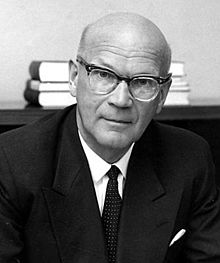Kekkonen
|
President Urho Kekkonen |
|
|---|---|

Urho Kekkonen in 1955
|
|
| 8th President of Finland | |
|
In office 1 March 1956 – 27 January 1982 |
|
| Prime Minister |
Karl-August Fagerholm Vieno Johannes Sukselainen Rainer von Fieandt Reino Kuuskoski Martti Miettunen Ahti Karjalainen Johannes Virolainen Rafael Paasio Mauno Koivisto Teuvo Aura Kalevi Sorsa Keijo Liinamaa |
| Preceded by | Juho Kusti Paasikivi |
| Succeeded by | Mauno Koivisto |
| 21st Prime Minister of Finland | |
|
In office 20 October 1954 – 3 March 1956 |
|
| President | Juho Kusti Paasikivi |
| Preceded by | Ralf Törngren |
| Succeeded by | Karl-August Fagerholm |
|
In office 17 March 1950 – 17 November 1953 |
|
| President | Juho Kusti Paasikivi |
| Preceded by | Karl-August Fagerholm |
| Succeeded by | Sakari Tuomioja |
| Minister of the Interior | |
|
In office 12 March 1937 – 1 December 1939 |
|
| Preceded by | Yrjö Puhakka |
| Succeeded by | Ernst von Born |
|
In office 17 March 1950 – 17 January 1951 |
|
| Preceded by | Aarre Simonen |
| Succeeded by | V. J. Sukselainen |
| Minister of Justice | |
|
In office 7 October 1936 – 12 March 1937 |
|
| Preceded by | Emil Jatkola |
| Succeeded by | Arvi Ahmavaara |
|
In office 17 November 1944 – 26 March 1946 |
|
| Preceded by | Ernst von Born |
| Succeeded by | Teuvo Aura |
|
In office 20 September 1951 – 22 September 1951 |
|
| Preceded by | Teuvo Aura |
| Succeeded by | Sven Högström |
| Minister of Foreign Affairs | |
|
In office 26 November 1952 – 9 July 1953 |
|
| Preceded by | Sakari Tuomioja |
| Succeeded by | Ralf Törngren |
|
In office 5 May 1954 – 20 October 1954 |
|
| Preceded by | Ralf Törngren |
| Succeeded by | Johannes Virolainen |
| Speaker of the Finnish Parliament | |
|
In office 22 July 1948 – 21 March 1950 |
|
| Preceded by | Karl-August Fagerholm |
| Succeeded by | Karl-August Fagerholm |
| Personal details | |
| Born |
3 September 1900 Pielavesi, Finland, Russian Empire |
| Died | 31 August 1986 (aged 85) Helsinki, Finland |
| Nationality | Finnish |
| Political party | Agrarian League 1933–1965: Centre Party 1965–1982 |
| Height | 1.81 m (5 ft 11 in) |
| Spouse(s) | Sylvi Salome Uino |
| Children | Matti, Taneli |
| Residence | Tamminiemi |
| Alma mater | University of Helsinki |
| Profession | Lawyer, police officer, journalist |
| Religion | Lutheranism |
| Signature | |
Urho Kaleva Kekkonen (pronounced [urho kekːonen]; 3 September 1900 – 31 August 1986) was a Finnish politician who served as Prime Minister of Finland (1950–1953, 1954–1956) and later as the eighth and longest-serving President of Finland (1956–1982). Kekkonen continued the “active neutrality” policy of his predecessor President Juho Kusti Paasikivi, a doctrine that came to be known as the “Paasikivi–Kekkonen line”, under which Finland retained its independence while maintaining extensive trade with members of NATO as well as those of the Warsaw Pact.
The son of Juho Kekkonen and Emilia Pylvänäinen, Kekkonen was born in Pielavesi, in the Savo region of Finland, and spent his childhood in Kainuu. His family were farmers (though not poor tenant farmers, as some of his supporters later claimed). His father was originally a farm-hand and forestry worker who rose to become a forestry manager and stock agent at Halla Ltd. Claims made that Kekkonen's family had lived in a rudimentary farmhouse with no chimney were later proved to be false—a photograph of Kekkonen's childhood home had been retouched to remove the chimney. His school years did not go smoothly. During the Finnish Civil War, Kekkonen fought for the White Guard (Kajaani chapter), fighting in the battles of Kuopio, Varkaus, Mouhu, and Vyborg, and taking part in mop-up operations, including leading a firing squad in Hamina. He later admitted to having killed a man in battle, but wrote in his memoirs that he was randomly selected by his company commander to follow a squad escorting ten prisoners, where the squad turned out to be a firing squad, and then to give the actual order to aim and fire.
...
Wikipedia
